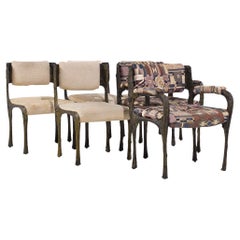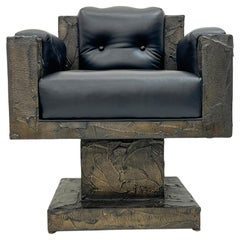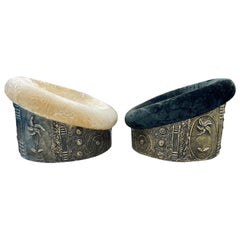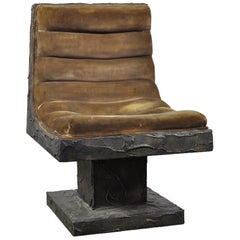Paul Evans Bronze Chairs
Vintage 1970s American Post-Modern Dining Room Chairs
Steel
Vintage 1970s American Mid-Century Modern Dining Room Chairs
Bronze
Vintage 1960s American Brutalist Armchairs
Bronze
Vintage 1960s American Brutalist Lounge Chairs
Resin, Wood
Recent Sales
Vintage 1960s American Modern Lounge Chairs
Bronze
Vintage 1960s American Lounge Chairs
Upholstery
Vintage 1970s American Brutalist Chairs
Bronze, Steel
Vintage 1970s American Brutalist Chairs
Bronze, Steel
Vintage 1970s American Dining Room Chairs
Bronze
Vintage 1970s American Chairs
Steel, Bronze
Vintage 1970s American Brutalist Lounge Chairs
Bronze
20th Century American Brutalist Dining Room Chairs
Bronze
Vintage 1970s American Mid-Century Modern Dining Room Chairs
Metal, Bronze
Vintage 1960s Dining Room Chairs
20th Century American Brutalist Dining Room Chairs
Upholstery, Resin
Vintage 1960s American Brutalist Dining Room Chairs
Composition, Metal
Mid-20th Century North American Mid-Century Modern Dining Room Chairs
Bronze
Vintage 1970s American Brutalist Dining Room Chairs
Steel
Vintage 1960s American Mid-Century Modern Dining Room Chairs
Bronze
20th Century American Mid-Century Modern Dining Room Chairs
Bronze, Steel
Vintage 1960s American Mid-Century Modern Dining Room Chairs
Bronze
Vintage 1960s American Modern Dining Room Chairs
Bronze
Vintage 1970s American Brutalist Dining Room Chairs
Vintage 1960s American Mid-Century Modern Dining Room Chairs
Bronze, Copper, Pewter, Steel
Vintage 1970s American Mid-Century Modern Lounge Chairs
Bronze, Copper, Steel
Vintage 1950s Chairs
Upholstery
American Dining Room Chairs
Vintage 1970s American Mid-Century Modern Dining Room Chairs
Metal, Bronze
Vintage 1970s American Brutalist Dining Room Sets
Bronze
20th Century American Brutalist Dining Room Sets
Bronze
20th Century American Dining Room Chairs
Bronze
Vintage 1970s American Dining Room Chairs
Vintage 1970s American Mid-Century Modern Armchairs
Bronze, Steel
Vintage 1970s American Dining Room Chairs
Bronze
20th Century American Brutalist Lounge Chairs
Bronze
20th Century American Dining Room Tables
Bronze
Vintage 1970s American Brutalist Chairs
Metal
Vintage 1960s Swivel Chairs
Vintage 1970s American Mid-Century Modern Dining Room Chairs
Metal, Bronze
Vintage 1960s American Mid-Century Modern Chairs
Bronze, Steel
Vintage 1970s American Dining Room Chairs
Bronze
Vintage 1960s American Chairs
Copper, Bronze, Pewter, Steel
Vintage 1970s American Dining Room Chairs
Leather
Vintage 1970s American Chairs
Steel, Bronze
Vintage 1970s American Chairs
Steel, Bronze
Vintage 1970s American Chairs
Metal
Vintage 1970s American Chairs
Metal, Bronze
Vintage 1970s American Dining Room Chairs
Steel, Bronze
Vintage 1970s American Dining Room Chairs
Steel, Bronze
Vintage 1960s American Dining Room Chairs
Copper, Bronze, Steel
Vintage 1970s American Dining Room Chairs
Bronze
Vintage 1960s American Chairs
Bronze
Vintage 1970s American Armchairs
Bronze
Vintage 1970s American Dining Room Tables
Metal, Bronze
Vintage 1970s American Mid-Century Modern Chairs
Metal
20th Century American Brutalist Chairs
Bronze
Vintage 1960s American Slipper Chairs
Upholstery
Mid-20th Century American Mid-Century Modern Chairs
Steel
Vintage 1970s American Mid-Century Modern Side Chairs
Steel
Vintage 1960s American Dining Room Chairs
Bronze
Vintage 1960s American Mid-Century Modern Side Chairs
Steel
Vintage 1970s American Mid-Century Modern Dining Room Chairs
Bronze, Metal
People Also Browsed
21st Century and Contemporary Swedish Scandinavian Modern Wall Lights an...
Metal
2010s American Animal Sculptures
Feathers
2010s South African Modern Side Tables
Copper, Steel
2010s South African Modern Side Tables
Brass
21st Century and Contemporary Italian Art Deco Wall Lights and Sconces
Brass
Vintage 1970s Swiss Mid-Century Modern Sectional Sofas
Fabric
Late 20th Century Italian Mid-Century Modern Sofas
Leather
2010s Italian Mid-Century Modern Chandeliers and Pendants
Brass
Early 20th Century Danish Art Deco Table Mirrors
Metal
Vintage 1980s Italian Mid-Century Modern Bookcases
Brass
Vintage 1960s North American Modern Coffee and Cocktail Tables
Glass
21st Century and Contemporary Italian Mid-Century Modern Chandeliers and...
Brass
2010s Italian Modern Chandeliers and Pendants
Metal, Brass
21st Century and Contemporary Italian Organic Modern Chandeliers and Pen...
Brass
Vintage 1970s Italian Mid-Century Modern Sofas
Upholstery
Vintage 1970s Belgian Brutalist Doors and Gates
Aluminum
Paul Evans Bronze Chairs For Sale on 1stDibs
How Much are Paul Evans Bronze Chairs?
Read More
All the Furniture in This Organic Modern Soho Loft Can Be Yours
Andrianna Shamaris has filled her epic new home with pieces of her own design.
20 Inviting Dining Rooms Perfectly Arranged for Entertaining
Top interior designers show — and tell — us how to create delectable spaces for hosting dinner parties.
Nobody Puts This Sunny Sofa in a Corner
With its plush cushions, cane details and dazzlingly colorful back, it’s inviting from every angle.
The 21 Most Popular Mid-Century Modern Chairs
You know the designs, now get the stories about how they came to be.
Fred Rigby’s Modular Seating Can Be Configured in So Many Handy Ways
The plush Cove Slipper 2.5 Seater sofa is just one of many convenient combinations from the London-based maker.
This Chubby-Chic Quilted Stool Stands on Its Own Two Feet
Sam Klemick's cool stool is edgy, cozy and environmentally sustainable all at once.
Is Lionel Jadot the Willy Wonka of Upcycled Belgian Design?
From his massive collaborative workshop in a former paper factory, the designer concocts funky furniture from disused materials, as well as luxe hotel interiors like the new Mix Brussels.
Rock Your Cares Away on This Sunny Hand-Crocheted Swing
The boho-chic Enchanted Forest Swing, handmade by marginalized women from Turkey and Syria, is uplifting in every way.





